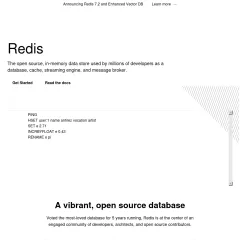
Redis
Redis is an open-source, in-memory data structure store. It is widely used as a fast and versatile database, cache, and message broker due to its high-performance capabilities and rich feature set.
Key Features:
- In-Memory Storage: Redis stores data in-memory, allowing for extremely fast read and write operations.
- Data Structures: It supports various data structures such as strings, hashes, lists, sets, and more, enabling complex data modeling and manipulation.
- Persistence: Redis offers options for data persistence, allowing data to be saved to disk, ensuring data durability even after restarts.
- Caching: Redis is commonly used as a cache due to its speed, which can significantly improve the performance of applications.
- Pub/Sub Messaging: It provides publish/subscribe messaging capabilities, making it suitable for building real-time applications and message queues.
Use Cases:
- Caching: Redis can be used to cache frequently accessed data, reducing the load on primary databases and speeding up application response times.
- Session Store: It's often used to store session data for web applications, allowing for quick retrieval and management of user sessions.
- Real-time Analytics: Redis's pub/sub features make it suitable for building real-time analytics and monitoring systems.
- Message Queues: It can be used to implement message queues for tasks that need to be processed asynchronously.
Advantages:
- High Performance: Redis's in-memory nature and optimized data structures contribute to its exceptional speed.
- Flexibility: Its versatile data structures make it suitable for various use cases beyond traditional databases.
- Community and Ecosystem: Redis has a large and active community, leading to extensive documentation, libraries, and tools.
Redis is a powerful data store known for its speed and versatility, making it a popular choice for caching, real-time applications, and various data manipulation tasks.
Conclusion:
Redis is a robust in-memory data structure store that offers high-performance capabilities for a wide range of applications. Its ability to handle caching, messaging, and data modeling tasks efficiently makes it a valuable tool in modern software development.